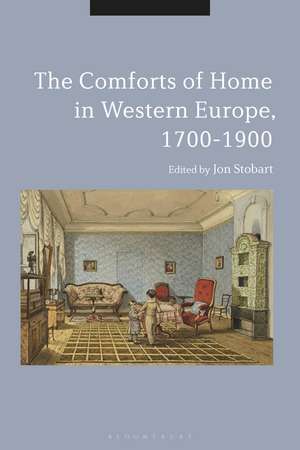The Comforts of Home in Western Europe, 1700-1900
Editat de Professor Jon Stobarten Limba Engleză Paperback – 25 aug 2021
| Toate formatele și edițiile | Preț | Express |
|---|---|---|
| Paperback (1) | 218.74 lei 6-8 săpt. | |
| Bloomsbury Publishing – 25 aug 2021 | 218.74 lei 6-8 săpt. | |
| Hardback (1) | 599.41 lei 6-8 săpt. | |
| Bloomsbury Publishing – 19 feb 2020 | 599.41 lei 6-8 săpt. |
Preț: 218.74 lei
Preț vechi: 275.44 lei
-21% Nou
Puncte Express: 328
Preț estimativ în valută:
41.86€ • 43.76$ • 35.37£
41.86€ • 43.76$ • 35.37£
Carte tipărită la comandă
Livrare economică 07-21 martie
Preluare comenzi: 021 569.72.76
Specificații
ISBN-13: 9781350246751
ISBN-10: 1350246751
Pagini: 240
Ilustrații: 28 bw illus
Dimensiuni: 156 x 234 x 20 mm
Greutate: 0.4 kg
Editura: Bloomsbury Publishing
Colecția Bloomsbury Academic
Locul publicării:London, United Kingdom
ISBN-10: 1350246751
Pagini: 240
Ilustrații: 28 bw illus
Dimensiuni: 156 x 234 x 20 mm
Greutate: 0.4 kg
Editura: Bloomsbury Publishing
Colecția Bloomsbury Academic
Locul publicării:London, United Kingdom
Caracteristici
It features 30 black and white illustrations and 10 case studies to illustrate how architectural ideas and innovations were put into practice in specific contexts
Notă biografică
Jon Stobart is Professor of History at Manchester Metropolitan University, UK. He is the editor of Travel and the British Country House: Cultures, Critiques and Consumption in the Long Eighteenth Century (2017) and the co-editor of A Taste for Luxury in Early Modern Europe: Display, Acquisition and Boundaries (Bloomsbury, 2017). He is also Founding Editor of the journal History of Retailing and Consumption.
Cuprins
List of IllustrationsList of TablesNotes on ContributorsIntroduction: Comfort, the Home and Home Comforts, Jon Stobart (Manchester Metropolitan University, UK)Part I - The Convenient House: Architectural Ideals and Practicalities1. Convenience, Utility and Comfort in British Domestic Architecture of the Long 18th Century, Dale Townshend (Manchester Metropolitan University, UK)People in Focus. Masters and Servants: Parallel Worlds in Blondel's Maisons de Plaisance, Aurélien Davrius (ENSA Paris-Malaquais, France)2. Northern Comfort and Discomfort: Spaces and Objects in Swedish Country Houses, c.1740-1800, Johanna Ilmakunnas (University of Turku, Finland)Object in Focus. Marketing the Necessary Comforts in Georgian Dublin, Conor Lucey (University College Dublin, Ireland)3. The Invention of Thermal Comfort in 18th-Century France, Olivier Jandot (Université d'Artois, France)Object in Focus. The Improved Tiled Stove: Sweden's Contribution to Defining Comfort? Cristina Prytz (Manchester Metropolitan University, UK)People in Focus. Keeping Warm with Sir John Soane, Diego Bocchini (Independent Scholar, Italy)4. The Spread of Comfort in 19th-Century Belgian Homes, Britt Denis (Universiteit Antwerpen, Belgium)Part II - Home Making: Objects and Emotions5. Home Making: Comfort in Victorian Middle-Class Homes in Britain and Beyond, Jane Hamlett (Royal Holloway, University of London, UK)Object in Focus. The Ideal Home in 1732: the Uppark Dolls' House as a Study in Comfort, Patricia Ferguson (British Museum, UK)Object in Focus. Comfort Compromised? The 'Bachelor Box' in Finland at the Turn of the 20th Century, Laika Nevalainen (European University Institute, Italy)6. Feeling at Home Abroad: Comfort, Domesticity, and Social Display on the Netherlandish Grand Tour (1585 - 1815), Gerrit Verhoeven (Universiteit Antwerpen, Belgium)People in Focus. Moving House: Comfort Disrupted in the Domestic and Emotional Lives of an 18th-Century Bachelor, Helen Metcalfe (University of Manchester, UK)7. Home from Home?: Making Life Comfortable in Victorian Barracks, Rowena Willard-Wright (English Heritage, UK)Object in Focus. A Wallpaper Sandwich: Comfort in the Student Room in 19th-Century Cambridge, Serena Dyer (Museum of Domestic Design and Architecture, UK)8. Making a Home: Family, Memory and Domestic Space in England c.1750-1830, Jon Stobart (Manchester Metropolitan University, UK)Object in Focus. The Comfort of Animal 'Things' in Late-Victorian Britain, Julie-Marie Strange (University of Manchester, UK)Afterthoughts: The Comforts of Home, Jon Stobart (Manchester Metropolitan University, UK)BibliographyIndex
Recenzii
These case studies . often steal the show, as it were, giving fascinating glimpses into topics ranging from the increasing importance of water closets, to lessons about comfort drawn from a doll's house, to the creation of comfort in Finnish bachelor pads. Summing Up: Recommended. Upper-division undergraduates through faculty.
The Comforts of Home in Western Europe, 1700-1900 offers the first wide-ranging study of the development of comfort in the home and makes a significant contribution to the history of every day life. The book's pan-European approach establishes comfort as an un-culturally specific phenomenon and will undoubtedly enable further examination of this fascinating field of study- stimulating historians of home, gender, architecture, material culture, and technology alike.
This collection of essays succeeds in illuminating aspects of domestic comfort in European culture during the onset of the industrial age.
Anyone wishing to understand the meaning of home will welcome the essays in this volume, which have much to say about how inextricably linked our concept of home is with the notion of comfort. By casting light on countries across Western Europe, and looking at the situations of men, women, and even pets, this splendid collection sets a high standard for investigations of domestic space and will appeal to readers across disciplines.
The Comforts of Home in Western Europe, 1700-1900 offers the first wide-ranging study of the development of comfort in the home and makes a significant contribution to the history of every day life. The book's pan-European approach establishes comfort as an un-culturally specific phenomenon and will undoubtedly enable further examination of this fascinating field of study- stimulating historians of home, gender, architecture, material culture, and technology alike.
This collection of essays succeeds in illuminating aspects of domestic comfort in European culture during the onset of the industrial age.
Anyone wishing to understand the meaning of home will welcome the essays in this volume, which have much to say about how inextricably linked our concept of home is with the notion of comfort. By casting light on countries across Western Europe, and looking at the situations of men, women, and even pets, this splendid collection sets a high standard for investigations of domestic space and will appeal to readers across disciplines.
